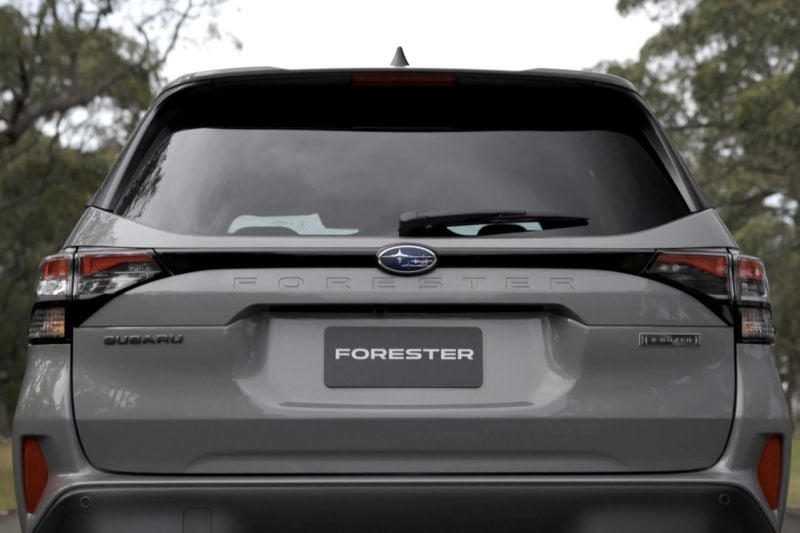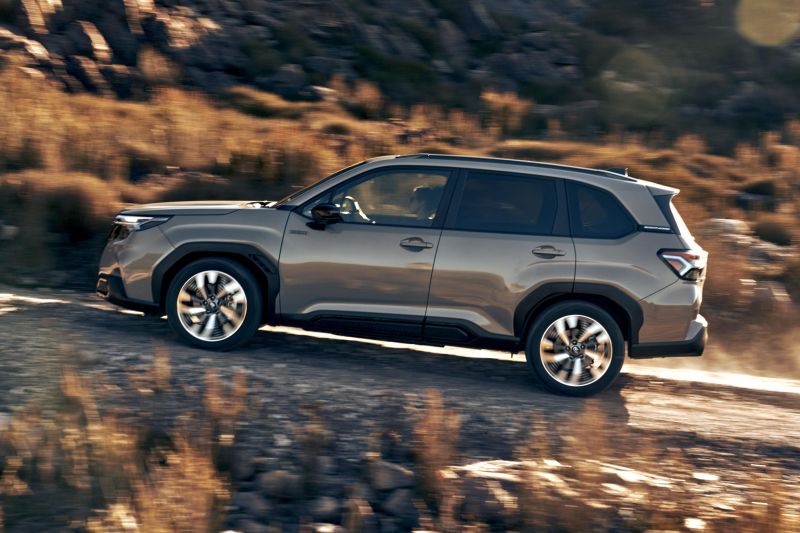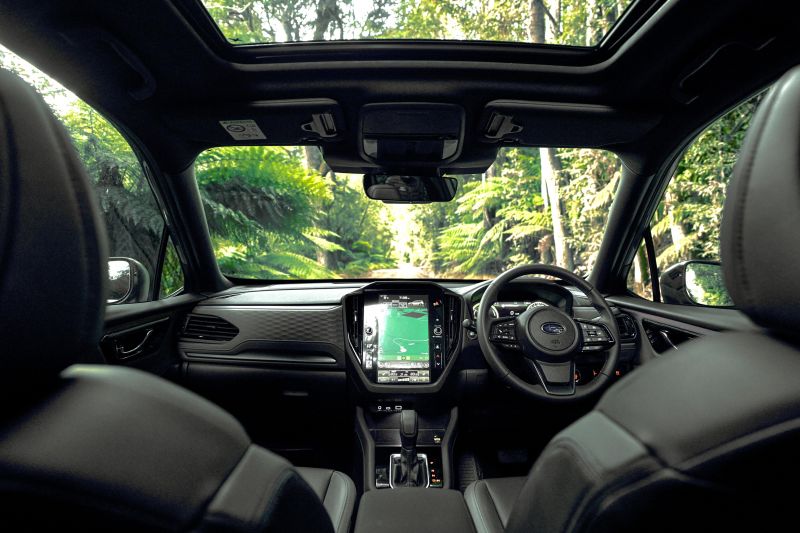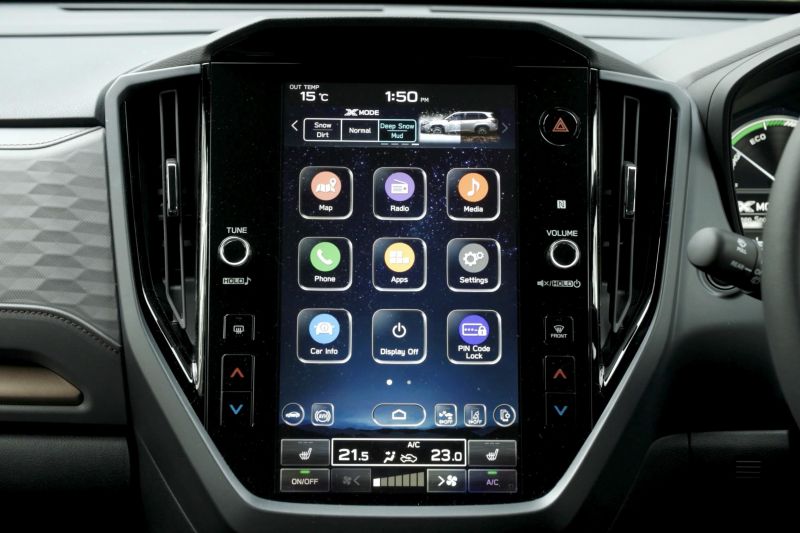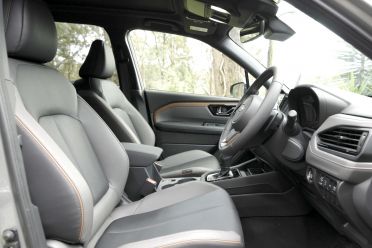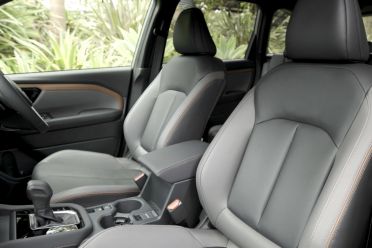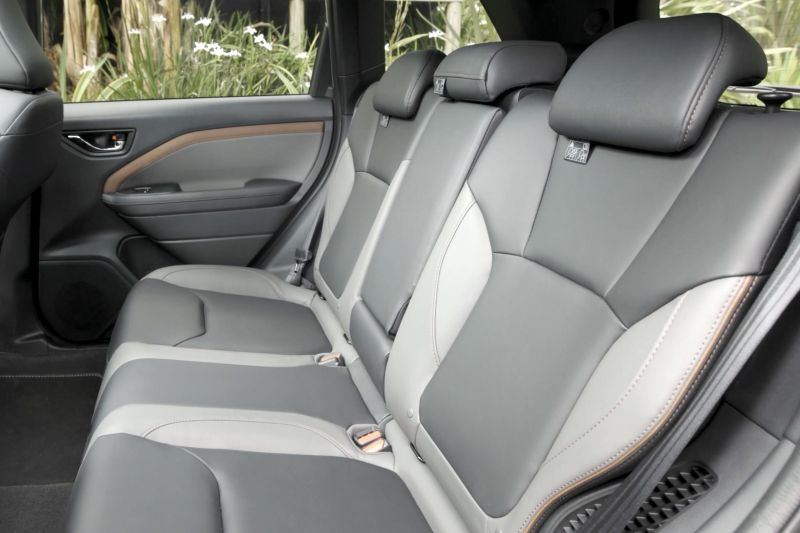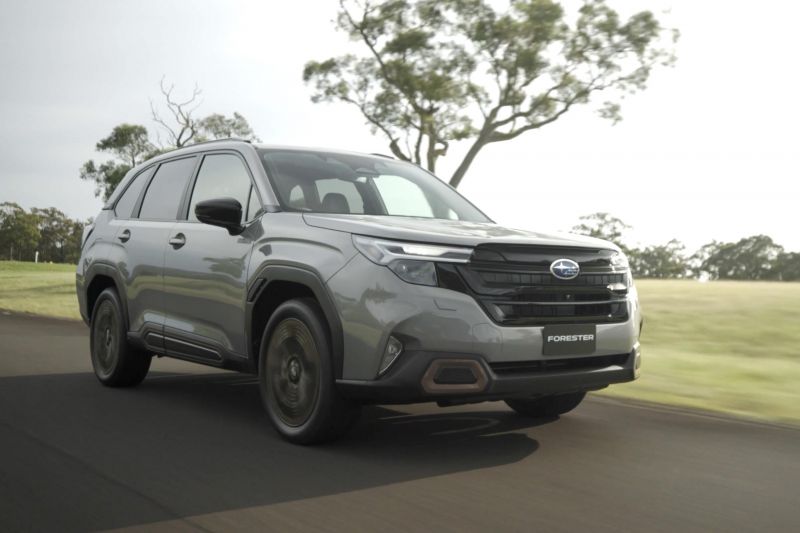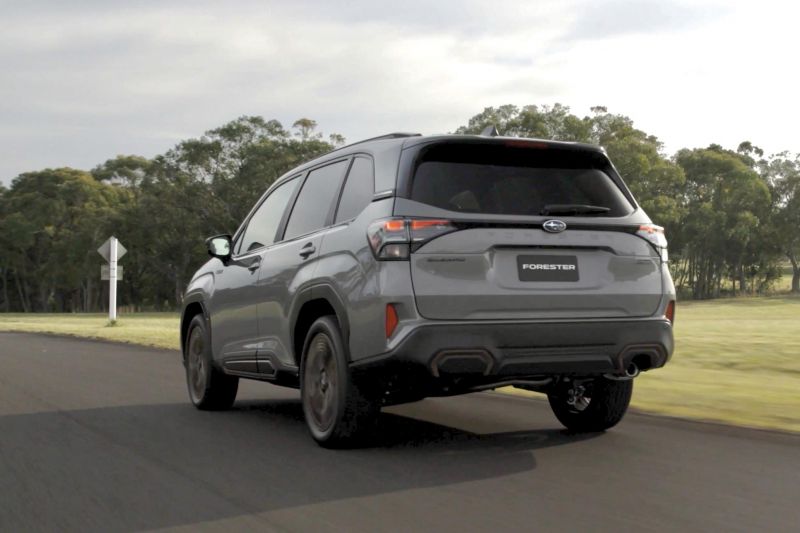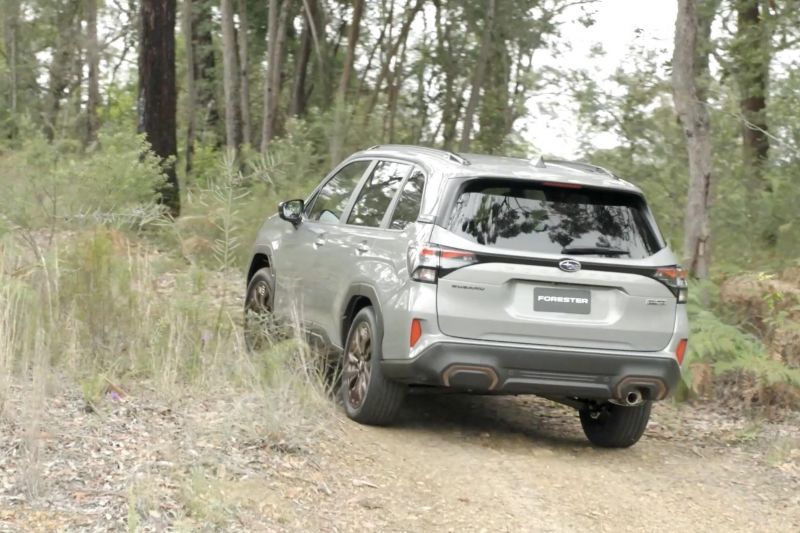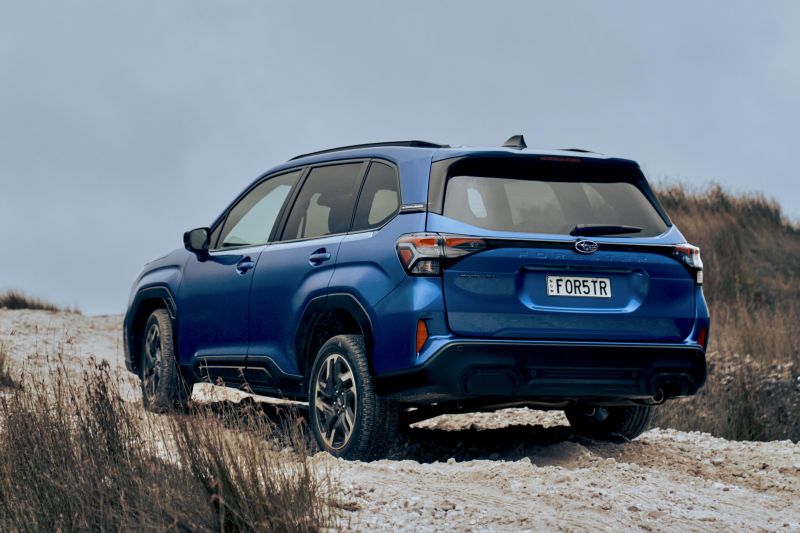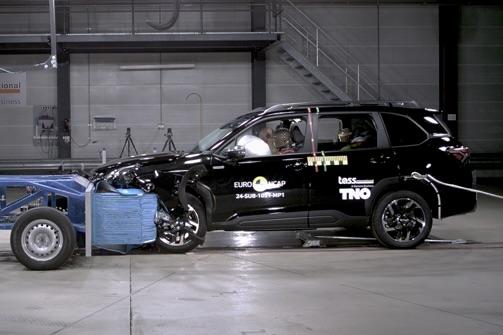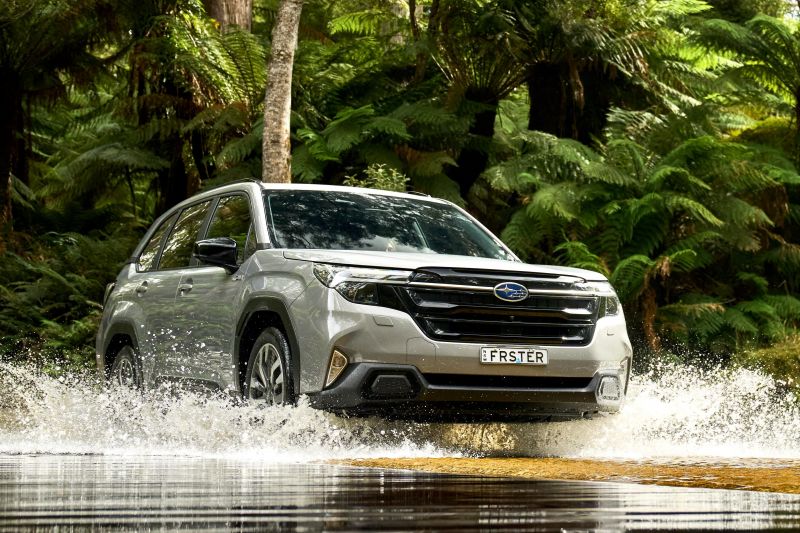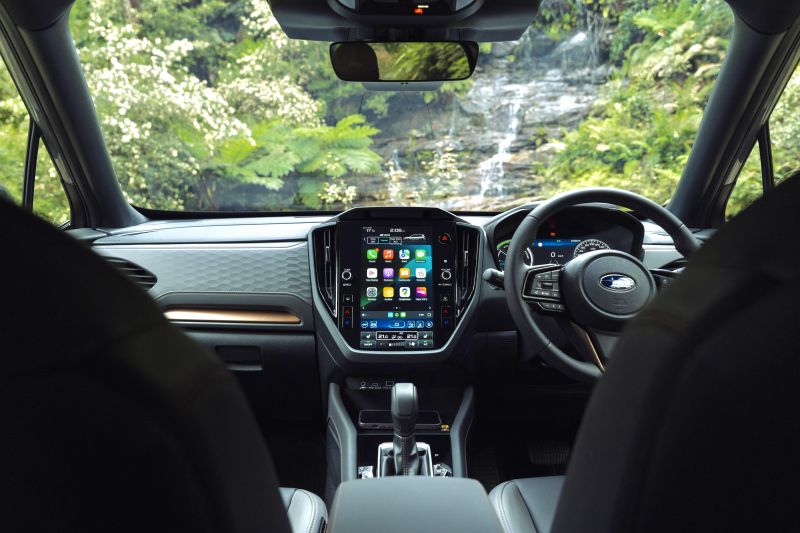The new Subaru Forester has finally arrived in Australia, but the redesigned mid-size SUVs you see here aren’t for sale.
The sixth-generation Forester was released in the United States some time ago, and we’ve briefly driven one in the United Kingdom. No we’ve had the opportunity to drive it on home turf, but not on public roads just yet.
Subaru Australia recently hosted media at a private facility in regional New South Wales to taste test two of the variants that will form part of the local Forester lineup. One was the updated petrol-only model, but the other was the real headline-grabber – the completely renewed Forester Hybrid, featuring full hybrid technology derived from Toyota.
Both vehicles still employ Subaru’s trademark flat-four ‘boxer’ engine, but the Hybrid adds a new-to-Subaru electric motor to the car’s continuously variable automatic transmission (CVT). This motor may boast the same outputs as the one in the Toyota RAV4 Hybrid AWD, but there’s one big difference.
As with all new Subarus bar the BRZ sports coupe, the new Forester is equipped with the Japanese brand’s longstanding ‘always-on’ Symmetrical All-Wheel Drive system. That means the front and rear axles are still connected via a central prop shaft, which feeds power to the rear wheels through a traditional differential, instead of the RAV4’s isolated petrol-driven front and electric-driven rear axles.
That gives the Forester Hybrid increased off-road capability, a laurel Subaru has continued to rest on well beyond the golden years of its World Rally Championship stardom.
Other updates include a completely new exterior design and a revised suspension tune, the latter of which is aimed at making the Forester feel more planted while reducing body roll in bends. Subaru has also developed two different suspension tunes for petrol-only and hybrid models to accommodate the different chassis demands.
It’s therefore a fairly comprehensive update for Subaru’s best-selling model in Australia, and one that was almost mandatory to help the Forester keep up with its hybrid SUV rivals, especially the top-selling RAV4.
Our test took place on a private tarmac circuit and a light off-road course, and we had the opportunity to drive both the top-spec Forester Touring petrol and the mid-spec Forester Hybrid Sport.
We were therefore unable to assess the car’s behaviour in regular on-road driving, or put its driver assist systems or real-world fuel economy to the test, and so this is strictly a pre-production quick drive review. A full detailed review will be published following the Forester’s official Australian launch in the coming months.
Are initial impressions promising, or has the Forester’s new hybrid system missed the mark?
How does the Subaru Forester compare?
View a detailed breakdown of the Subaru Forester against similarly sized vehicles.

Subaru
Forester
How much does the Subaru Forester cost?
We don’t know! Subaru Australia says it’ll confirm pricing for the new Forester closer to its local launch.
We can, however, speculate based on a couple of factors – as we did when early details were announced.
In Australia, the fifth-generation Forester petrol range starts at $38,690 before on-roads for the base 2.5i and tops out at $47,140 before on-roads for the 2.5i-S – excluding the STI Sport special edition priced at $48,640 before on-roads.
There are two hybrids currently available, the Hybrid L and Hybrid S, which cost $44,090 and $50,140 before on-roads respectively.
In the US, the base Forester is priced at US$29,995 (around A$47,000), while the cheapest Premium Hybrid costs US$34,995 (around A$55,000), putting them roughly on par with US-market RAV4s.
While we can’t compare previous-generation Forester pricing in the US, we can look to other Subaru models for an estimate. The Crosstrek, for example, starts at US$25,810 (around A$40,500) in North America, while the Australian equivalent costs US$35,490 before on-roads – a difference of roughly $6000 once converted.
If Subaru Australia follows suit, the sixth-generation Forester would start at around $41,000 before on-roads here, and the hybrid could start at around $49,000. For context, a base all-wheel drive Toyota RAV4 GX eFour costs $45,260 before on-roads.
Below is the lineup confirmed to be coming to Australia:
- 2026 Subaru Forester base
- 2026 Subaru Forester Premium
- 2026 Subaru Forester Sport
- 2026 Subaru Forester Touring
- 2026 Subaru Forester Hybrid base
- 2026 Subaru Forester Hybrid Sport
- 2026 Subaru Forester Hybrid Touring
To see how the Subaru Forester stacks up against its rivals, use our comparison tool
What is the Subaru Forester like on the inside?
Very typical of a modern Subaru, and that means it’s a mixed bag.
We didn’t get the chance to properly examine everything inside on a busy day, but there are a few defining features. One is the huge central touchscreen, which is the first time we’ve seen such a unit in a Forester.
This is what we already get in most other Subarus in Australia, and so those familiar with the brand’s other current models should already know what it’s all about. A series of general shortcuts dominate its home screen, while you also get an always-on climate display at the bottom.
We don’t love how the climate functions have evolved from the physical setup in the outgoing Forester, but at least there are still some buttons to control the demister and temperature, as well as a couple of knobs on either side.
Gone is the isolated screen that used to sit atop the dashboard, with the information previously displayed there now relocated down on the main infotainment display. You also get wireless smartphone mirroring as standard.
You’ll find it in the ribbon along the top of the screen, which also includes info regarding power delivery, traction control, off-road angles, and drive modes. Eligible functions can also be controlled here via touch.
We think that moving key safety functions and off-road controls into a touchscreen display is counterintuitive. While they’re easy to find, it’s still more fiddly than simply pressing a button. The use of gloss black plastic around the screen is also a little much.
Our quick stints behind the wheel also showed proved the seats are comfortable and well-bolstered, as well as power-adjustable on every grade from Premium and up. All in all, there aren’t a lot of differences between the petrol and Hybrid Forester grades inside, but the ones that exist are significant.
One is behind the steering wheel, as the two top Hybrid grades now benefit from the Australian Forester’s first-ever digital instrument cluster.
-
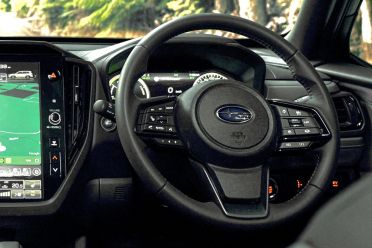
-
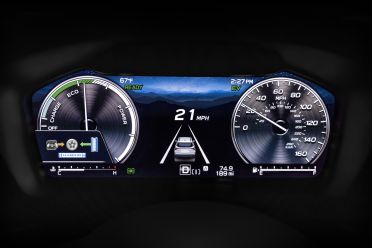
Overseas Hybrid model shown
At a glance, this 12.3-inch display looks the part, albeit graphically basic, and there are a handful of different displays to flick through using a button on the left of the steering wheel. More time with this display will reveal all it’s hiding, but it appears to be a quality addition.
You get a typical hybrid power readout through one of the set layouts, much like what you’ll find in a hybrid Toyota or Honda. The base Hybrid and all petrol Foresters get standard analogue gauges and a small digital panel in the middle.
The steering wheel itself is also a fairly standard Subaru unit, and it feels nice in the hands. The leather used to wrap it doesn’t feel as soft as in some other cars, but we like the hard-wearing, chunky buttons fitted to the horizontal spokes.
Elsewhere, you’ll find a button to prioritise electric vehicle (EV) mode to the right of the wheel, as well as other basic switchgear to adjust things like the headlight level, for example. All par for the course for Subaru.
Strangely, the centre console feels quite sparse and utilitarian in comparison to everything else, regardless of the variant. There’s a traditional gear selector for one, which is surrounded by leather-look trim and a gloss black panel.
All Foresters will get a wireless charging pad, AUX input, USB-C outlet, and USB-A outlet ahead of this shifter, but behind it is a big piece of dull black plastic.
Two cupholders have been moulded into this panel, and it’s also where you’ll find the electric parking brake, a 12V outlet, and a button to view the Forester’s cameras – especially useful when off-roading.
Appearance-wise, we weren’t impressed by this central portion. It isn’t heinous, but it’s a little disappointing that you seem to get the same plasticky arrangement at the top of the lineup as you do at the bottom – and that the outgoing Forester seems nicer here.
The Forester’s key touch points are at least all nice to interact with. The soft armrests and high-quality leather upholstery in the cars we drove were no exceptions, but we expect what will likely be cloth trim in lower-spec variants to be comfortable too.
While it’s all functional, there’s no doubt the Forester still looks somewhat dated inside. The colours and material choices play a part here, and there’s a big jump between this and what we’ve seen overseas with the new Outback.
It’s a similar story in the second row, though we do appreciate the two-tone upholstery available in some grades. There’s not a lot going on back here, but there is a lot of room all around.
The rear bench is comfortable enough, and there’s a fold-down central armrest with cupholders, plus two rear-facing air vents, and both USB-C and USB-A ports.
-
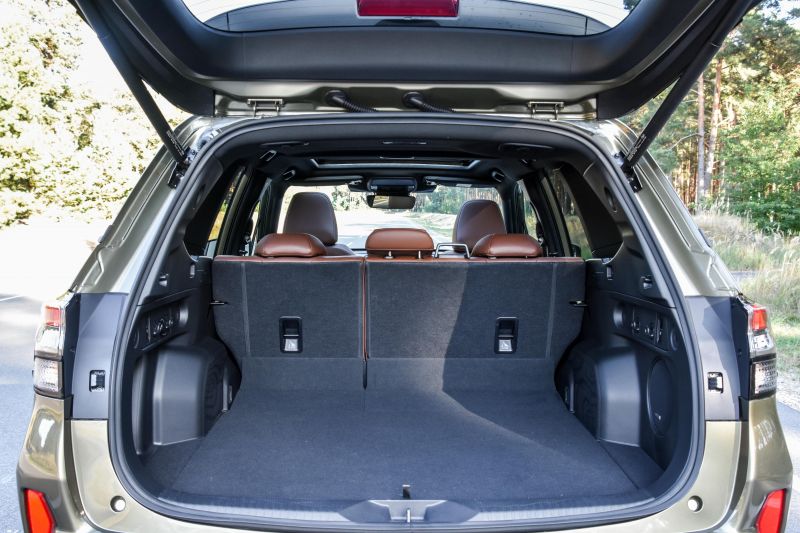
Overseas model shown
Boot space appears to be generous, and without an official capacity figure, we expect it to be marginally larger than the 498 litres offered in the current Forester. All but the base Forester in the new range will get a powered tailgate too, complete with a kick sensor.
What isn’t clear is whether these Foresters get any form of spare wheel, but given the previous Forester Hybrid was only fitted with a tyre repair kit, we’re not holding our breath. A tyre repair kit is standard for Hybrids overseas.
Petrol models may still get a spare in Australia, and it’s entirely reasonable to want a full-size spare, especially if you’re the type to take your Forester off sealed roads on the weekend.
Generally, the interior of the new Forester is a sensible upgrade over the current model, even if we’d still like a few more buttons and a more modern overall look.
| Dimensions | Subaru Forester |
|---|---|
| Length | 4655mm (+15mm) |
| Width | 1828mm (+13mm) |
| Height | 1730mm |
| Wheelbase | 2670mm |
Length, width, height, and wheelbase measurements are for sixth-generation Foresters delivered in the North American market, and the difference is compared to current Foresters delivered locally.
To see how the Subaru Forester stacks up against its rivals, use our comparison tool
What’s under the bonnet?
We know there are two versions of Subaru’s 2.5-litre naturally aspirated four-cylinder ‘boxer’ petrol engine and a new hybrid powertrain coming to Australia for the next Forester, but the brand has been very coy on technical specifications thus far.
-
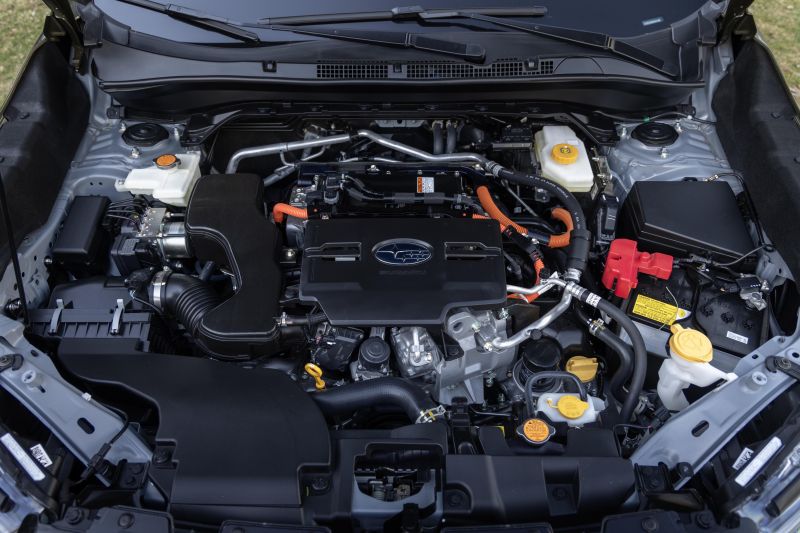
Overseas Hybrid model shown
| Specifications | Subaru Forester petrol | Subaru Forester Hybrid |
|---|---|---|
| Engine | 2.5L flat 4cyl petrol | 2.5L flat 4cyl hybrid |
| Engine outputs | TBC | TBC |
| Electric motor outputs | – | 88kW |
| System outputs | – | TBC |
| Battery | – | 1.1kWh |
| Transmission | Lineartronic CVT | Lineartronic e-CVT |
| Drive type | All-wheel drive | All-wheel drive |
| Weight | TBC | TBC |
| Fuel economy (claimed) | TBC | TBC |
| Fuel tank capacity | TBC | TBC |
| Fuel requirement | TBC | TBC |
| CO2 emissions | TBC | TBC |
| Emissions standard | TBC | TBC |
| Braked tow capacity | TBC | TBC |
To give you an idea of the upgrade the Forester Hybrid has received, the outgoing model utilises an electric motor producing just 12kW of power and 66Nm of torque to supplement its smaller 2.0-litre boxer four, which produces 100kW and 196Nm on its own. And the 2.5-litre engine in the outgoing Forester produces 136kW/239Nm in Australia.
Subaru USA quotes outputs of 180hp (134kW) and 178lb-ft (241Nm) for its updated petrol Forester and a total system power output of 194hp (145kW) for the hybrid.
To see how the Subaru Forester stacks up against its rivals, use our comparison tool
How does the Subaru Forester drive?
If you’ve driven the current Forester, you’ll immediately notice similarities.
For a start, the new Forester is not at all fast. The naturally aspirated boxer in petrol variants is effectively unchanged from the current car, which means it still feels a little underdone.
As before, it doesn’t shove you back into your seat, spring away from a stop, or make a particularly nice noise, even if the latter is a result of the endlessly revvy CVT.
That’s not exactly surprising, and this isn’t meant to be a sports car. The same can be said for the Hybrid, but there has at least been a drastic improvement in the way the system operates.
You’re able to trundle along at speeds of under 30km/h on purely electric power, and anything faster will have the petrol engine fire up as you continue to accelerate. In stark contrast to feedback on the outgoing Forester Hybrid, the new car offers a seamless transition between the two methods of propulsion.
This is where the Toyota influence comes into play. Aside from the recogniseable boxer noises – purely mechanical noises, not the exhaust note – you’d be hard pressed to feel a huge difference between this and a RAV4, especially in normal on-road driving.
That may sound uninspiring, but we actually think it’s a good thing. The Forester desperately needed a hybrid system that was up to scratch, and it now has one. And on first impressions, it seems like it can kick it with the popular kids from the Toyota and Honda families.
As expected, the hybrid battery is charged via both the engine and regenerative braking. The latter can be controlled using steering wheel paddles in some variants, and they offer an interesting function.
Their operation feels a lot like shifting the transmission, so much so that you can’t go into too high a regen mode if you’re travelling above a certain speed, much like the way you can’t downshift to the lowest gears at highway speeds in a standard automatic.
Even so, regen braking is acceptably strong for a hybrid with a small battery. You can’t rely on it to bring the car to a stop, of course, but it’s a good way to scrub off some speed while recuperating energy.
You also get a battery level readout on the digital instrument cluster, which can show the flow of power like in other modern hybrids. Time using this system on public roads will reveal more flaws, but it’s certainly promising.
It still isn’t all that quick, at least not in comparison to the petrol. This suggests that the 2.5-litre engine is detuned for the heavier Hybrids, with the difference made up by that 88kW motor – one of the only mechanical specifications currently confirmed by Subaru Australia.
That’s a bit of a shame, but you do still get Subaru’s SI-Drive, which can switch between subdued and aggressive throttle responses, and it’s here where you notice more of a change in the Hybrid than you do in the petrol.
The Forester Hybrid isn’t meant to blow you away. Instead, it’s meant to offer a reliable hybrid system as a realistic alternative to the segment heavy-hitters, potentially at a friendlier price than the RAV4.
A key separation is Subaru’s other big update, which regards the Forester’s suspension. It’s marginally firmer than before, but it offers improved body control for both on-road stability and off-road capability.
On-road, we were surprised to find the Forester behaves somewhat like the current Forester STI Sport does, with slightly reduced body roll and generally more confident handling. That car featured dampers tuned by the brand’s STI performance arm, making it feel a bit sportier.
The new Forester is by no means stiff, but the similarities hint at a well-engineered upgrade. Subaru Australia also says there are different suspension tunes for petrol and hybrid Foresters because of their different weight demands.
Off-road, the Forester offers impressive capability. Subaru was proud to have maintained ground clearance of 220mm, which is noticeable once you hit trails with a few rocks and inclines.
It’s by no means a hardcore off-roader, but Subaru’s all-wheel drive system will surprise you if you haven’t had the chance to properly try it before.
In conjunction with X-Mode, which offers snow/dirt and deep snow/mud settings, the Forester seems capable of outperforming most of its closest rivals. Subaru says this is a result of the mechanical link between the front and rear axles.
Snow/dirt mode dulls torque output and dials up traction control to minimise wheel slip, while deep snow/mud does the opposite. You can flick between these while on the move too, and the difference is easy to feel.
Better yet, driving with X-Mode engaged automatically enables hill descent control, which remembers your speed and can adjust to throttle and brake inputs on the fly.
Interestingly, the operation of hill descent control in petrol vehicles sounds fairly harsh as the car grapples with its anti-lock brakes, but the hybrid seems to rely more on regen braking and offers a smoother experience.
In any case, it’s quite a clever system, which can also adapt to the terrain by sending power to the wheels with the most traction if it senses you’re getting stuck. Having a full suite of camera displays while on the move off-road also helps with vehicle positioning.
Based on our brief first drive on local soil, the new Forester performs promisingly. Even if it isn’t entirely revolutionary, it builds on the positive aspects of the outgoing model while benefiting from the expertise of the world’s hybrid leader.
To see how the Subaru Forester stacks up against its rivals, use our comparison tool
What do you get?
There are seven grades of the new Forester: four petrols and three hybrids. A full equipment list is not yet available.
-
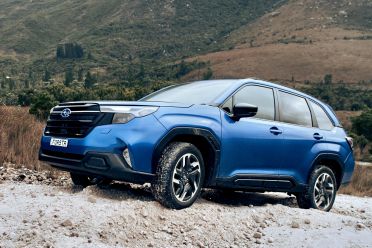
Forester Touring -
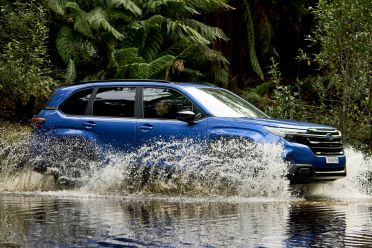
2026 Subaru Forester equipment highlights:
- 18-inch alloy wheels
- Ladder-style roof rails
- ‘X-Mode’ with one drive mode
- Subaru Intelligent Drive (SI-Drive) with two modes
- 11.6-inch portrait touchscreen infotainment system
- Wireless Apple CarPlay
- Wireless Android Auto
- Wireless phone charger
- Heated front seats
Forester Premium adds:
- Powered tailgate with kick sensor
- 8-way power-adjustable front seats with lumbar
- Satellite navigation
- Auto-folding side mirrors
Forester Sport adds:
- Dark metallic 18-inch alloy wheels
- Electric sunroof
- ‘X-Mode’ with two drive modes
- Black front grille with green insert
- Green badging
- Water-repellent synthetic leather upholstery
- Leather-wrapped steering wheel
- Green interior stitching
Forester Touring adds:
- Gloss black front grille, front and rear bumper accents, side mirrors
- Low-profile roof rails
- Leather and suede upholstery in black or brown
- Ventilated front seats
- 10-speaker Harman Kardon sound system with subwoofer
-
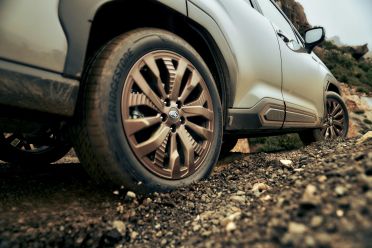
Forester Hybrid Sport -
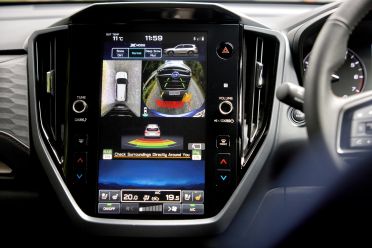
Forester Hybrid adds (over base Forester):
- Sports regeneration steering wheel paddles
Forester Sport Hybrid adds (over Forester Sport):
- Bronze 19-inch alloy wheels
- “Enhanced suspension for improved comfort on bumpy roads”
- Bronze exterior accents
- Low-profile roof rails
- 12.3-inch digital instrument cluster
- 10-speaker Harman Kardon sound system with subwoofer
Forester Touring Hybrid adds (over Forester Touring):
- Dark grey machined gloss finish 19-inch alloy wheels
To see how the Subaru Forester stacks up against its rivals, use our comparison tool
Is the Subaru Forester safe?
The updated Subaru Forester is yet to receive an ANCAP safety rating, but it was awarded five stars by sister organisation Euro NCAP.
| Category | Subaru Forester (Euro NCAP) |
|---|---|
| Adult occupant protection | 83 per cent |
| Child occupant protection | 89 per cent |
| Vulnerable road user protection | 86 per cent |
| Safety assist | 72 per cent |
Standard safety equipment includes:
- 9 airbags, including:
- Far-side
- Front passenger seat cushion
- Surround-view camera
- Autonomous emergency braking with reverse function
- Driver monitoring system
- Front-side sensor
- Subaru EyeSight
- Wide-angle monocular camera
- Emergency driving stop system
To see how the Subaru Forester stacks up against its rivals, use our comparison tool
How much does the Subaru Forester cost to run?
Subaru Australia backs its lineup with a five-year, unlimited-kilometre warranty, along with an eight-year, 160,000km warranty for the high-voltage batteries of its electric and hybrid vehicles.
| Servicing and Warranty | Subaru Forester |
|---|---|
| Warranty | 5 years, unlimited kilometres |
| Battery warranty | 8 years, 160,000km |
| Roadside assistance | 12 months complimentary |
| Service intervals | TBC |
| Capped-price servicing | TBC |
| Total capped-price service cost | TBC |
To see how the Subaru Forester stacks up against its rivals, use our comparison tool
CarExpert’s Take on the Subaru Forester
The new Forester presents as a good package with many promising aspects.
We don’t yet know how its driver assist tech will work or how economical the new Hybrid can be, but they will be among the first things we’ll test when we can finally drive it in public. From what we experienced at Subaru’s pre-production event, it’s clear that serious work has been put into the car.
The petrol version is largely the same as before, though its chassis control is noticeably better, but the hybrid is much better than before, providing smooth operation and logical switching between EV and petrol power.
Subaru has also dialed up the advantage of the superior hybrid tech into the Forester’s off-road performance, and that’s a good thing. You have greater control over throttle response and torque delivery, which makes it easier not to get stuck.
Those in the know will appreciate the benefits of having a traditional prop shaft and rear diff setup, which provides a noticeable cohesion between the front and rear axles at all times.
The new Forester’s interior isn’t quite as impressive, at least not in the context of the latest mid-size SUVs.
Its screen is big but can be a little cumbersome to navigate, and we’d still prefer a physical climate control interface like what the new Outback appears to be getting. The use of hard plastics is also fairly uninviting and detracts from the cabin experience.
Subaru’s ergonomics have at least remained strong, and the seats are quite nice. We also like that we get some items that feel much more premium in the higher-spec trim levels, like that new digital instrument display.
We’ll reserve judgment until we drive it more extensively in a few months, but it seems Subaru is on the right track with its next Forester.
Interested in buying a Subaru Forester? Get in touch with one of CarExpert’s trusted dealers here
Click the images for the full gallery
MORE: Everything Subaru Forester




